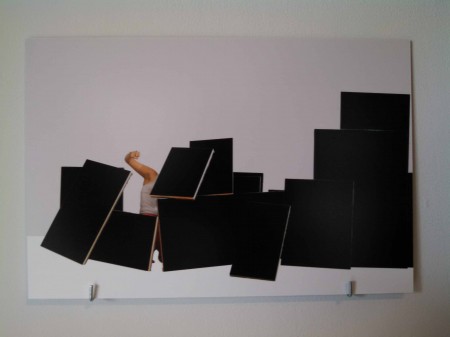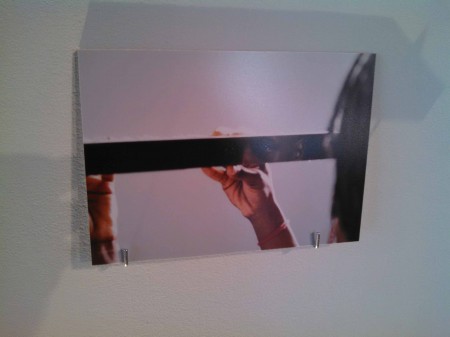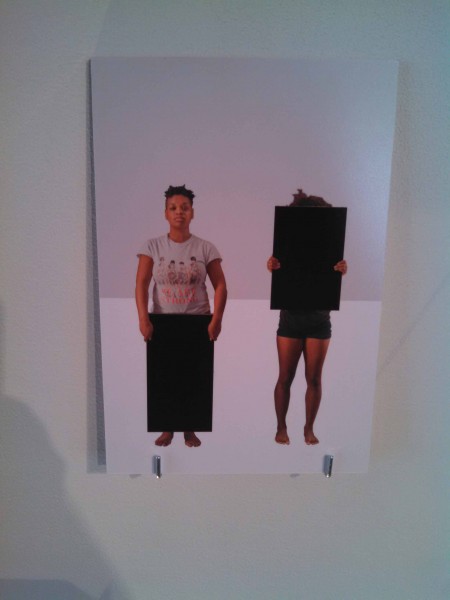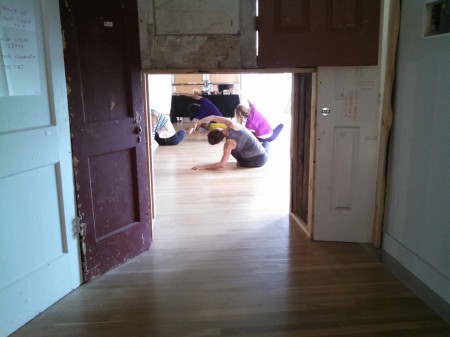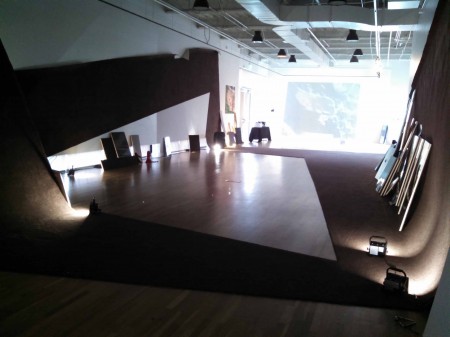“Amateurs rehearse until they get it right; professionals rehearse until they can’t get it wrong.”
That quote is often attributed to Julie Andrews. I heard it recently on a professional development podcast, referring to pitching and public speaking. It came to mind again at “The School for the Movement of the Technicolor People” (The School) at DiverseWorks in Houston, on view through May 28—at least, the idea of rehearsal did. That’s because the exhibit is a working rehearsal space, hosting different types of dance classes every Saturday.
But, The School is less about rehearsing a show than it is rehearsing a dialogue of respect, empowerment, and lifting others up, whatever their skin color or sexuality. taisha paggett and the dance company WXPT (We are the Paper, We are the Trees), in collaboration with Ashley Hunt and Kim Zumpfe, created the installation in response to “the limited position of Black and queer movers in the dance and art worlds amidst the evolving violence against Black bodies, gentrification, and the persistent erasure of communities of color throughout history.”*
So, one could consider rehearsal, in this case, a rehearsal for survival. In the same way, “movement” also takes on two meanings, both in terms of dance/physical expression and a sociopolitical movement.
Two of paggett’s emails to WXPT, Hunt and Zumfe with instructions for rehearsal are displayed, illuminating the method and intention of a rehearsal in The School. They include:
“read through these directions . . . please note, everything is meant to be translated.”
“learn each other’s names and pronouns.”
“do something that requires you to hold and be held by another.”
“at some point, laugh together.”
“audio record this.”
“discuss this.”
The School isn’t only about dancing. It is a dialogue of expression, support, and preservation in a world not designed for its students.
paggett also references the black mirrored panels leaning against the gallery walls, which are to be handled by dancers and audience members during performance and rehearsal. They create a sort of void against a dancer’s body, even as they reflect their image and surrounding light. Shiny black on one side and carpeted on the other, they manipulate its pilot’s shape and presence. Scratches and fingerprints are deliberately allowed to remain as pieces of its handler’s movement and The School’s history. They don’t have meaning until they are obscuring someone, which is why photos of people using the panels were displayed throughout. Additionally, iconic photos of Black dancers are wedged between select panels, from Alvin Ailey to Soul Train.
I’m not sure what would have happened if I’d grabbed a panel to try a few poses. The instruments of dance begged for movement, but I stayed within the constraints of art gallery decorum.
The whole set-up might feel a little half-baked if dancing did not actually occur in the space, but every Saturday through the end of the exhibition, free dance classes are available to the public in a variety of genres. I called ahead and was assured that I would be welcome to either participate or observe, so showed up around the same time as an earthy-looking modern dance instructor. Three dancers trickled in, and began their practice. From what I could hear, the instructor didn’t go through the entire introduction process in the email, just quickly and quietly described the opening exercise (one person rolling across another’s back and legs, perpendicularly) before starting to teach a sequence, which mostly took place on the floor and only used a fraction of the gallery space.
Other features provide context for dance as political act. “Erasure” is a physical focus: besides the voids created by the black mirrored boards, an enclave of doors one has to stoop to enter encases one corner of the gallery. It contains the saga of the demolition of the C.B. Dansby Colored High School, a black high school believed to be founded by paggett’s ancestors in the early 1900s. Photos depict the abandoned building (the town officially integrated its schools in 1970), and the empty space left afterward. The school becomes a symbol not necessarily of segregation or oppression, but of Black pedagogy and presence.
A slideshow, “All the questions from Unit One of the 1964 Mississippi Freedom School Curriculum,” flips through an anti-racist educational initiative that accompanied that year’s effort to register as many African-American voters as possible. These questions are still prescient, considering present-day neighborhood division and voting rights. Another projection, “This Body is Revolting,” features audio of Frank Wilderson, an artist and professor of drama and African American Studies at UC-Irvine, speaking to the politicalness of the Black body, and the constant state of violence against it. It plays over rehearsal footage of Black dancers literally lifting one another up, resulting in what may be the installation’s most powerful illustration.
Black stretches of carpet denote the school’s “primary learning and performance space” and create the most immediate visual drama, covering maybe a third of the floorspace. (The modern dance class participants start on it, but eventually roll their way off onto a more spacious area.) Since the carpet dramatically sweeps up one wall, supported by a separate platform, it can be assumed that that performance would defy gravity at least once: thrilling to imagine, even without dancers to perform the feat. In reality, the carpet was cut to fit the School’s inaugural exhibition at Los Angeles Contemporary Exhibitions, and carries the physical history that the School’s creators so ardently value. Additionally, the parallelogram is a recurring theme in paggett’s work, and “acts as a queer shape forever in between points of stability.”
All these program citations should tell you that you will benefit from having a program close at hand; think of it as a textbook, akin to paggett’s rehearsal instructions. The School is most informative when the student (gallery-goer, in this case) lingers in the enclave of decaying Texas doors, crouches on the black carpet as dancers move the air, and watches the slideshow of “anti-racist questions” in its entirety. No, I wouldn’t normally sit in the middle of a gallery floor. But here, in the intricacies of intention, creation and preservation, it feels right; this is a space that grants permission.
*Because the program language capitalizes “Black” when referring to Black people, I have done the same in this review. Besides that, taisha paggett does not use capital letters when writing, and this is reflected in citations.
